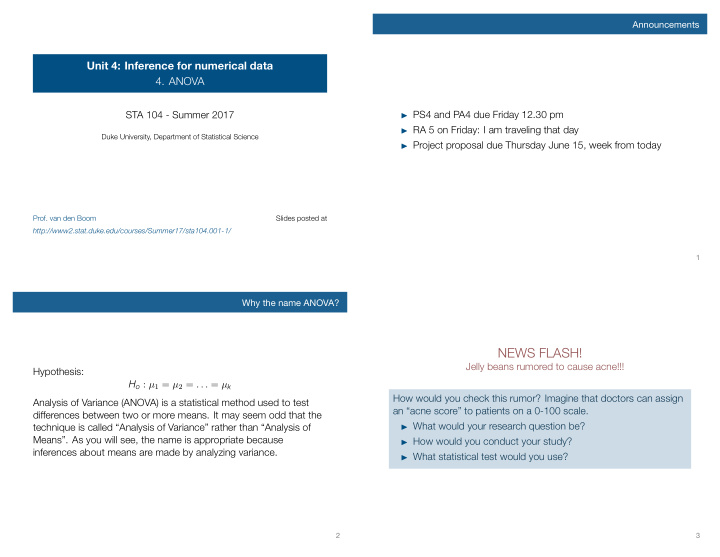



Announcements Unit 4: Inference for numerical data 4. ANOVA STA 104 - Summer 2017 ▶ PS4 and PA4 due Friday 12.30 pm ▶ RA 5 on Friday: I am traveling that day Duke University, Department of Statistical Science ▶ Project proposal due Thursday June 15, week from today Prof. van den Boom Slides posted at http://www2.stat.duke.edu/courses/Summer17/sta104.001-1/ 1 Why the name ANOVA? NEWS FLASH! Jelly beans rumored to cause acne!!! Hypothesis: H o : µ 1 = µ 2 = . . . = µ k How would you check this rumor? Imagine that doctors can assign Analysis of Variance (ANOVA) is a statistical method used to test an “acne score” to patients on a 0-100 scale. differences between two or more means. It may seem odd that the ▶ What would your research question be? technique is called “Analysis of Variance” rather than “Analysis of Means”. As you will see, the name is appropriate because ▶ How would you conduct your study? inferences about means are made by analyzing variance. ▶ What statistical test would you use? 2 3
Clicker question Suppose α = 0 . 05 . What is the probability of making a Type 1 error and rejecting a null hypothesis like H 0 : µ purple jelly bean − µ placebo = 0 when it is actually true? http://imgs.xkcd.com/comics/significant.png (a) 1% (b) 5% (c) 36% (d) 64% (e) 95% 4 5 Conditions on ANOVA Clicker question Suppose we want to test 20 different colors of jelly beans versus a placebo with hypotheses like H 0 : µ purple jelly bean − µ placebo = 0 H 0 : µ brown jelly bean − µ placebo = 0 1. Independence : H 0 : µ peach jelly bean − µ placebo = 0 (a) within group: sampled observations must be independent ... (b) between group: groups must be independent of each other and we use α = 0 . 05 for each of these tests. What is the probability 2. Approximate normality : distribution should be nearly normal of making at least one Type 1 error in these 20 independent tests? within each group 3. Equal variance : groups should have roughly equal variability (a) 1% (b) 5% (c) 36% (d) 64% (e) 95% 6 7
ANOVA tests for some difference in means of many different groups ANOVA compares between group variation to within group variation Null hypothesis: ∑ | 2 / ∑ | 2 = BETWEEN / WITHIN = SSG / SSE H 0 : µ placebo = µ purple = µ brown = . . . = µ peach = µ orange . Clicker question Which of the following is a correct statement of the alternative hypothesis? (a) For any two groups, including the placebo group, no two group means are the same. (b) For any two groups, not including the placebo group, no two group means are the same. (c) Amongst the jelly bean groups, there are at least two groups that have different group means from each other. (d) Amongst all groups, there are at least two groups that have different group means from each other. 8 9 To identify which means are different, use t-tests and the Bonferroni correction For historical reasons, we use a modification of this ratio called the F -statistic: F = SSG / ( k − 1) MSG = ▶ If the ANOVA yields a significant results, next natural question SSE / ( n − k ) MSE is: “Which means are different?” k : # of groups; n : # of obs. ▶ Use t-tests comparing each pair of means to each other, – with a common variance ( MSE from the ANOVA table) instead of each Df Sum Sq Mean Sq F value Pr( > F) group’s variances in the calculation of the standard error, Between groups SSG MSG k − 1 F obs p obs – and with a common degrees of freedom ( df E from the ANOVA table) Within groups n − k SSE MSE ▶ Compare resulting p-values to a modified significance level Total n − 1 SSG+SSE α ⋆ = α Note: F distribution is defined by two dfs: df G = k − 1 and K df E = n − k R code to compute p -value: where K = k ( k − 1) is the total number of pairwise tests 2 pf(F_obs, df1 = df_G, df2 = df_E, lower.tail = FALSE) 10 11
Summary of main ideas 1. Comparing many means requires care Application exercise: 4.4 ANOVA 2. ANOVA tests for some difference in means of many different groups See the course webpage for details. 3. ANOVA compares between group variation to within group variation 4. To identify which means are different, use t-tests and the Bonferroni correction 12 13
Recommend
More recommend